Product Images Paclitaxel
View Photos of Packaging, Labels & Appearance
- Paclitaxel Structural Formula - paclitaxel 01
- paclitaxel 01a
- Figure 1. Survival: Cc Versus Tc (Intergroup) - paclitaxel 02
- Figure 2. Survival: Cc Versus Tc (GOG-111) - paclitaxel 03
- Figure 3. Disease-Free Survival: AC Versus AC+T - paclitaxel 04
- Figure 4. Survival: AC Versus AC+T - paclitaxel 05
- Figure 5. Disease-Free Survival: Receptor Status Negative/Unknown AC Versus AC+T - paclitaxel 06
- Figure 6. Disease-Free Survival: Receptor Status Positive AC Versus AC+T - paclitaxel 07
- Figure 7. Disease-Free Survival: Premonopausal AC Versus AC+T - paclitaxel 08
- Figure 8. Disease-Free Survival: Postmenopausal AC Versus AC+T - paclitaxel 09
- PRINCIPAL DISPLAY PANEL - 50 mL Vial Label - paclitaxel 10
- PRINCIPAL DISPLAY PANEL - 50 mL Vial Carton - paclitaxel 11
- paclitaxel 12
- paclitaxel 13
- paclitaxel 14
- paclitaxel 15
- paclitaxel 16
- paclitaxel 17
Product Label Images
The following 18 images provide visual information about the product associated with Paclitaxel NDC 61703-342 by Hospira, Inc., such as packaging, labeling, and the appearance of the drug itself. This resource could be helpful for medical professionals, pharmacists, and patients seeking to verify medication information and ensure they have the correct product.
Figure 2. Survival: Cc Versus Tc (GOG-111) - paclitaxel 03
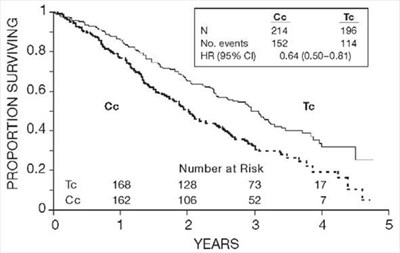
This is a statistical table presenting the proportion of survivors and related data. The table seems to contain information about a comparison between two groups (N 214, 196) with the number of events, hazard ratio, and number at risk indicated. There are also numbers representing the years, possibly indicating the time period observed.*
Figure 3. Disease-Free Survival: AC Versus AC+T - paclitaxel 04
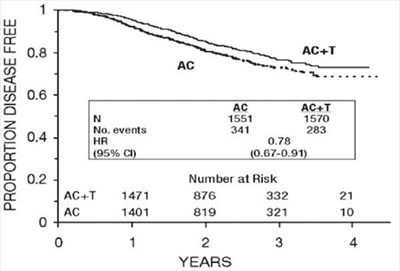
This appears to be a table related to the proportion of disease-free people treated with AC+T and AC in a medical study. It includes information on the number of events and the hazard ratio over a span of four years. It is not possible to determine the context or specifics of the study from this text.*
Figure 4. Survival: AC Versus AC+T - paclitaxel 05
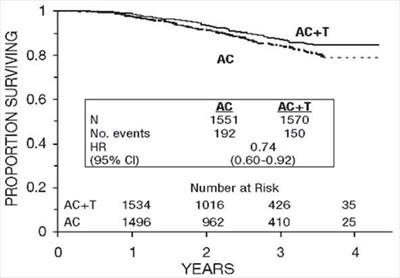
This appears to be a table with information related to survival rates of individuals undergoing a specific treatment (AC+T) compared to a control treatment (AC) over a period of four years. The table includes information such as the number of individuals at risk, number of events (presumably deaths), and hazard ratio. However, without further context or information, it is difficult to understand the purpose or significance of this data.*
Figure 5. Disease-Free Survival: Receptor Status Negative/Unknown AC Versus AC+T - paclitaxel 06
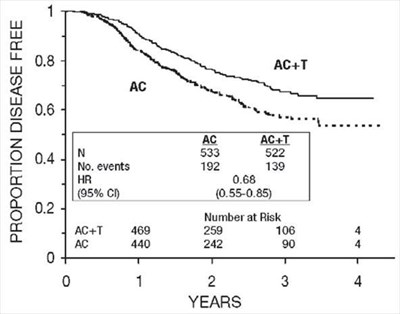
The text is a table with data related to disease-free proportions. It includes different treatments or interventions (AC+T and AC) and their corresponding number of events, hazard ratio, and risk numbers. The table spans for up to 5 years.*
Figure 6. Disease-Free Survival: Receptor Status Positive AC Versus AC+T - paclitaxel 07
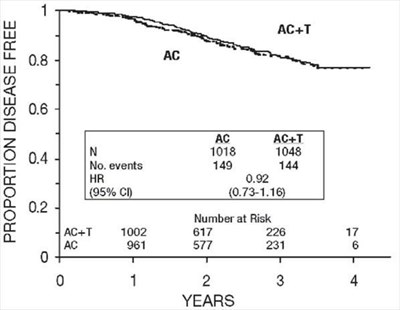
This appears to be a section of a research or clinical trial report, documenting the proportion of disease-free individuals based on a given treatment regimen (AC+T) compared to a control group (AC). The table provides numerical values for the number of participants and the number of disease events observed, as well as the hazard ratio and confidence interval. The graph represents the proportion of disease-free individuals over a period of 4 years.*
Figure 7. Disease-Free Survival: Premonopausal AC Versus AC+T - paclitaxel 08
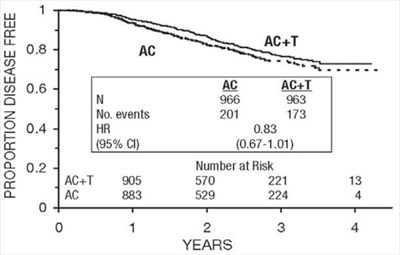
This text appears to be statistical output from a medical or scientific study. It shows the proportion of participants in the study who are disease-free over a period of four years. The study included 966 individuals, and 201 of them experienced an event related to the disease in question. The results suggest that the use of AC+T treatment may have a slightly lower hazard ratio (HR) of 0.83, but the 95% confidence interval ranged from 0.67-1.01, indicating that the difference may not be statistically significant. The text also includes a table showing the number of participants at risk over the four-year period for different treatment groups.*
Figure 8. Disease-Free Survival: Postmenopausal AC Versus AC+T - paclitaxel 09
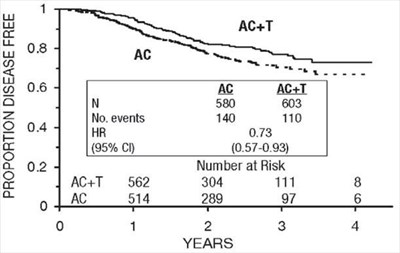
This appears to be a chart or graph related to medical research. It shows proportions of people who were disease-free over a period of time. There are two groups represented, labeled as AC+T and AC. The numbers 04 and 02 may represent years or time intervals. The HR value of 0.73 suggests that the group labeled AC+T had a lower risk of disease compared to the AC group. The numbers in the "Number at Risk" column may indicate the number of participants in each group. Overall, the chart seems to be related to a study on a particular disease and the effectiveness of a treatment.*
paclitaxel 13
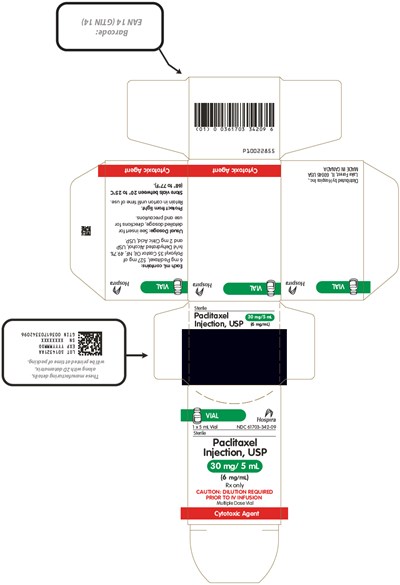
This appears to be a mix of diverse texts, including various numbers, symbols, and characters, which makes it challenging to generate a particular description. It seems that there are some medical-related terms present in the text, including Paclitaxel Injection, USP 30 mg/ 5 mL, which is a cytotoxic agent used in the treatment of different cancers. There is also a caution noted that dilution is required before intravenous infusion. However, the rest of the text appears to be a mix of random letters, numbers, and symbols, which cannot be used to provide further information. Therefore, the description would be: "Medical-related text including information about Paclitaxel Injection, USP."*
paclitaxel 14
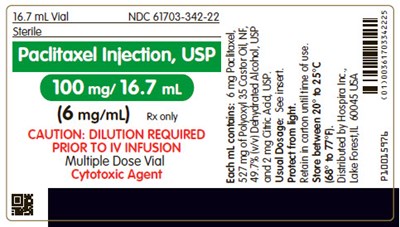
The text contains information about a drug called Paclitaxel Injection, USP, which is a cytotoxic agent that needs to be diluted before IV infusion. It is available in a multiple dose vial containing 100mg/16.7ml of the drug at a concentration of 6 mg/mL. The text also includes some illegible characters and symbols, and a few numbers that might be references to product codes or batch numbers.*
paclitaxel 15
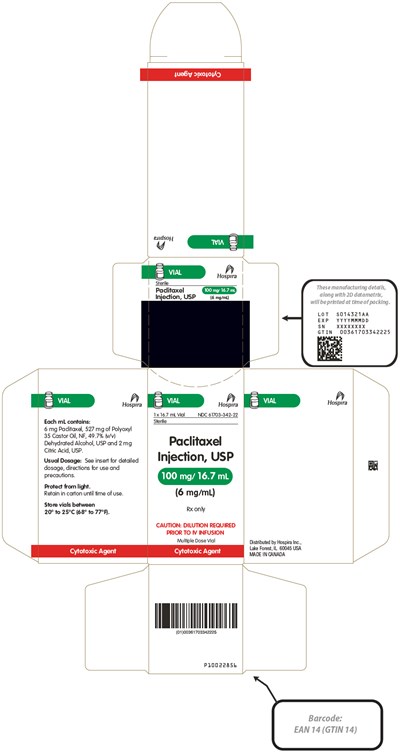
Paclitaxel Injection is a cytotoxic agent. Each mL contains 6 mg of Paditaxel, 527 mg of Polyoxy 35 Castor Oil, NF, 49.7% Dehydrated Alcohol USP, and 2 mg Citric Acid, USP. The usual dosage, directions, and precautions are included in the insert. Protect from light and store the vials at room temperature. Dilution is required before the intravenous infusion. The manufacturing details and 2D datamatrix are printed on the packaging. It is distributed by Hospira Inc., Lake Forest, IL 60045, USA. MADE IN CANADA. The barcode EAN 14 (GTIN 14) is included.*
paclitaxel 17
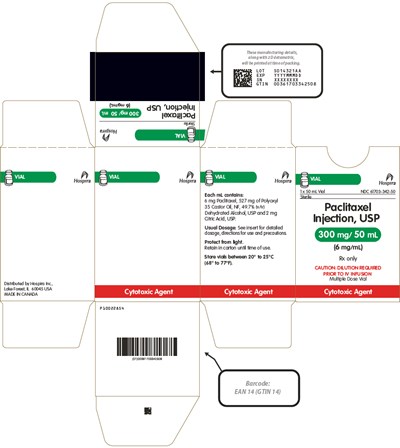
This is a description of a medication called Paclitaxel, in the form of a 50 mLvial with 6 mg/mt dosage. It contains Polyaxyl, Castor O, Dehydrated Alcohol, and U Injection as its ingredients. A detailed dosage and usage instructions are available in the insert. Dilution is required before intravenous infusion. The lot number is s014321AA, and the bar code is EAN 14. The medication is distributed by Hospira Inc.*
* The product label images have been analyzed using a combination of traditional computing and machine learning techniques. It should be noted that the descriptions provided may not be entirely accurate as they are experimental in nature. Use the information in this page at your own discretion and risk.






